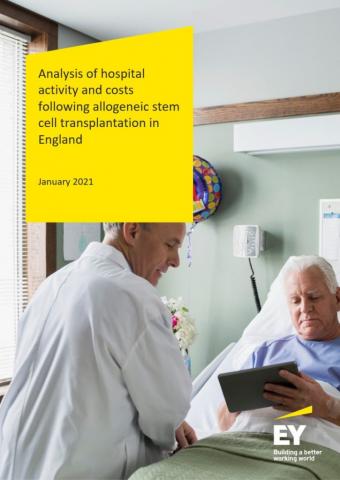The NHS Long-Term Plan commits to exploring new payment models to ensure that patients are able to receive the right care, in the right place, at the right time. The COVID-19 pandemic has in some way advanced changes to the way healthcare is paid for as the NHS looks at maintaining differences in payment models introduced during the pandemic. At Anthony Nolan, we want to understand what different payment models might mean for stem cell transplant patients. That is why last year we worked with EY to start filling some gaps in the evidence base. The findings show that for people who had a stem cell transplant, hospital activity can remain significant up to a year after the procedure, underpinning our call for a review of the payment model for stem cell transplantation and supporting our work on the importance of the post-transplant care pathway.
Why is it important to look at the stem cell transplantation payment model in England?
In 2019 1,714 people in the UK received an allogeneic stem cell transplant. This is a potentially lifesaving treatment for people with blood cancers and blood disorders. However, during recovery patients can experience a range of physical and psychological late-effects (also known as ‘long-term complications’), which may be ongoing, severe and life-threatening. Despite international consensus around the importance of long-term follow-up, evidence shows that there is substantial variation in the provision of post-transplant care across the UK. As a result, patients do not have equal access to treatment, care and support.
People we’ve spoken to have suggested that one reason there has been variation in post-transplant care across the country is due to the current payment model for stem cell transplantation. However, the lack of economic data relating to stem cell transplantation makes it difficult to understand how the current payment model may be driving variation and also hinders discussions about new payment models.
In England, NHS England commissions services 30 days prior to and up to 100 days after stem cell transplantation. These are called ‘Specialised Services’. They are advised by a group of experts known as the Blood and Marrow Transplantation Clinical Reference Group (BMT CRG). Beyond this point, commissioning responsibility transfers to approximately 200 local Clinical Commissioning Groups (CCGs).
What did the research find?
The study found that on average a year after discharge a patient will have experienced:
- Four elective or non-elective inpatient spells in hospital
- 16 day cases or regular day attendances (including chemotherapy)
- 38 outpatient appointments
- 44 bed days as an inpatient (in addition to 33 days for the transplant spell itself)
- Two days in critical care
While hospital activity generally declined over time, it remained significant beyond 100 days. Within the study we were unable to conduct subgroup analysis, but it is fair to assume that hospital activity will vary depending on a wide range of factors including the patient’s age, their original diagnosis and the severity of any late effects such as Graft vs Host Disease (GvHD).
Costs also remained significant beyond 100 days. The costs incurred between 100 days and 365 days after discharge were £70.0m nationally (or almost a third of total costs).
Despite the limitations of our analysis, these findings suggest that the current payment model for stem cell transplantation may benefit from review. The 100-day cut-off does not reflect the fact that hospital activity and costs remain significant beyond this point.
What recommendations does the report make?
The report makes three recommendations:
- NHSE/I, in collaboration with providers, should explore the potential benefits of a new payment model for stem cell transplantation in line with the ambitions of the NHS Long Term Plan. They should also take steps to ensure that the underpinning data relating to hospital activity, costs –and income –is of the highest possible quality
- Further research needs to be taken to answer the following questions:
a) What hospital activity, costs and income are associated with allogeneic stem cell transplant patients beyond the first 365 days after discharge (and what about activity outside of hospitals)?
b) How do hospital activity and costs vary by patient group, for example by age, original diagnosis, type of allogeneic stem cell transplant, GvHD status and/or socioeconomic background? - Further research should also be undertaken to explore how the post-transplant care pathway may help prevent issues occurring later down the line and therefore reduce costs.
Next steps
Variation in post-transplant care is unacceptable in itself, but even more so considering the potential impact on patient outcomes and experience. Poorly managed late-effects can put pressure on healthcare providers due to readmissions and additional inpatient days. For commissioners, it makes no sense to invest in a treatment without ensuring that it has the best chance of success.
We’ll be using this report to talk to decisionmakers at NHSE/I on the activity and costs associated with a stem cell transplant. We will also continue to work on the post-transplant care pathway which describes the services and support packages that are central to patients’ recovery.
